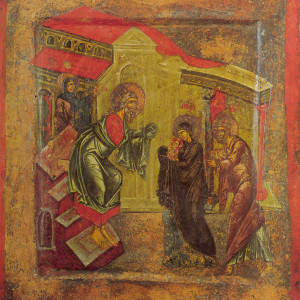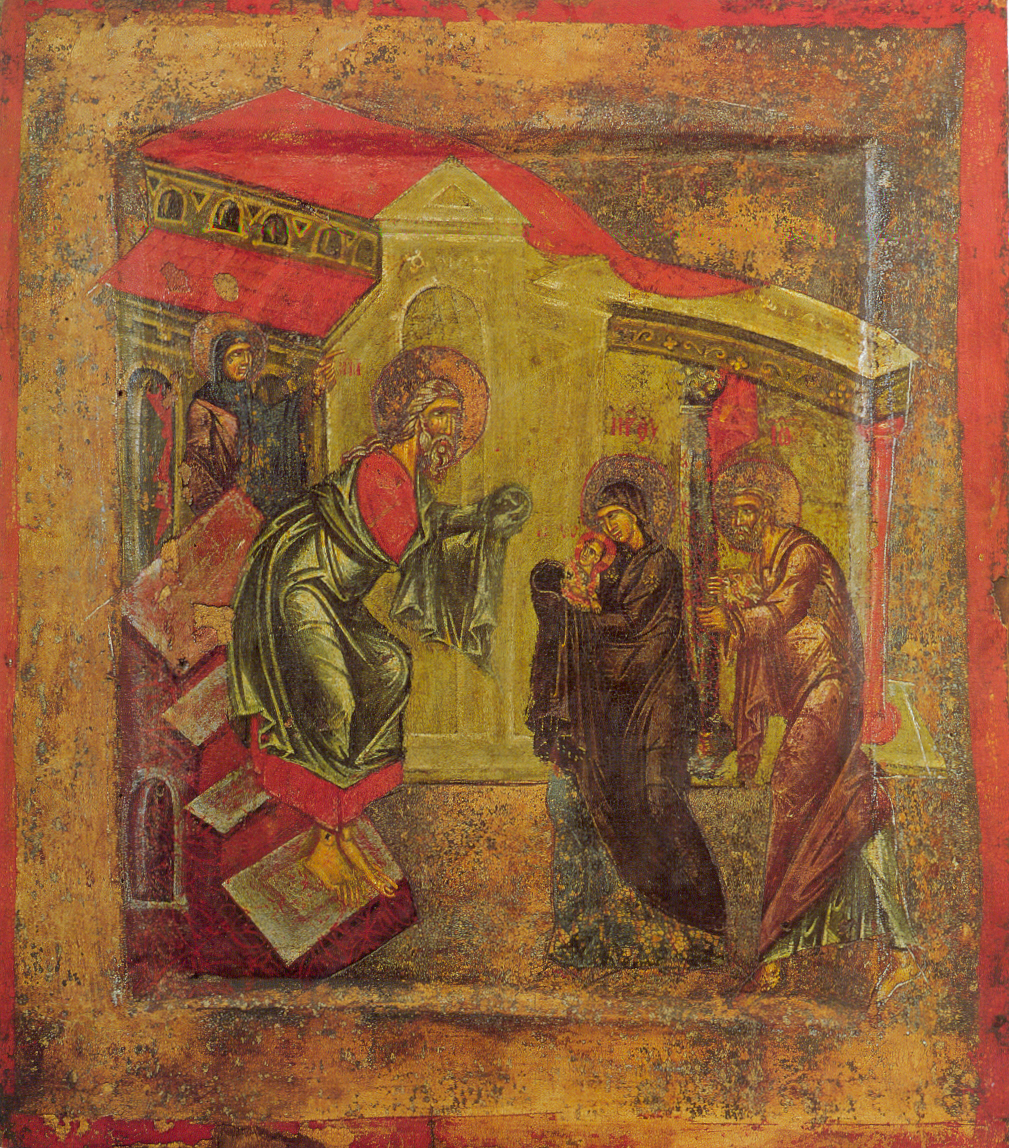Mary is a living image of the Church, which is why we refer to both Mary and the Church as Mother. St. Ambrose describes Mary in this way, in explainingLuke 1:27:
Presentation of Jesus at the Temple (Kastoria icon) (14th c.) Well [does the Gospel say]: married but a virgin; because she is the type of the Church, which is also married but remains immaculate. The Virgin [Church] conceived us by the Holy Spirit and, as a virgin, gave birth to us without pain. And perhaps this is why holy Mary, married to one man[Joseph], is made fruitful by another [the Holy Spirit], to show that the individual churches are filled with the Spirit and with grace, even as they are united to the person of a temporal priest.
Lumen Gentium picks up on these themes, showing the New Eve imagery to be a both/and, not an either/or, between Mary and the Church:
63. By reason of the gift and role of divine maternity, by which she is united with her Son, the Redeemer, and with His singular graces and functions, the Blessed Virgin is also intimately united with the Church. As St. Ambrose taught, the Mother of God is a type of the Church in the order of faith, charity and perfect union with Christ.(18*) For in the mystery of the Church, which is itself rightly called mother and virgin, the Blessed Virgin stands out in eminent and singular fashion as exemplar both of virgin and mother. (19*) By her belief and obedience, not knowing man but overshadowed by the Holy Spirit, as the new Eve she brought forth on earth the very Son of the Father, showing an undefiled faith, not in the word of the ancient serpent, but in that of God’s messenger. The Son whom she brought forth is He whom God placed as the first-born among many brethren,(299) namely the faithful, in whose birth and education she cooperates with a maternal love.
So both Mary and the Church are Virgin Mothers. St. Paul uses virginal imagery to describe the sinlessness of the Church in Ephesians 5:25-27, depicting the Church as a pure and spotless Bride awaiting Her Souse, Christ. And, of course, Mary is a Virgin (Lk. 1:34). Yet both become Mothers: biologically, in the case of Mary, and spiritually, in the case of both Mary and the Church.
| Mary and the Child (Sinai icon) (13th c.) |
This Virgin Mother imagery is found interweaved throughout the Old Testament. We hear echoes in Genesis 3:15 (about the Seed of the Woman, suggesting that a man wasn’t involved). We also hear it in Hannah’s song in 1 Samuel 2:5, in which Hannah cries out,
She who was barren has borne seven children,
but she who has had many sons pines away.
More obviously, we can see it in Isaiah 54:1-5, in which Zion is depicted as a Virgin Mother:
“Sing, barren woman, you who never bore a child; burst into song, shout for joy, you who were never in labor; because more are the children of the desolate woman than of her who has a husband,” says the LORD.
“Enlarge the place of your tent, stretch your tent curtains wide, do not hold back; lengthen your cords, strengthen your stakes. For you will spread out to the right and to the left; your descendants will dispossess nations and settle in their desolate cities.
“Do not be afraid; you will not be put to shame. Do not fear disgrace; you will not be humiliated. You will forget the shame of your youth and remember no more the reproach of your widowhood.
For your Maker is your husband— the LORD Almighty is his name— the Holy One of Israel is your Redeemer; he is called the God of all the earth.”
And this is why it’s important that the Virgin Mary was a Virgin — why it was worth specifying in the prophesy in Isaiah 7:14. Because her Virginity is an external symbol of her sinlessness, and utter devotion to God.


“God wishes to establish in the world, devotion to My Immaculate Heart…” Our Lady of the Rosary at Fatima, July 13, 1917
When are the Popes going to grant God’s wish?
This already happened, back in 1942.